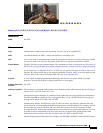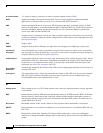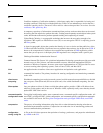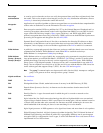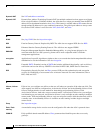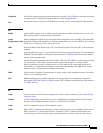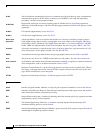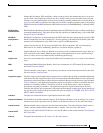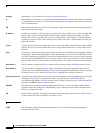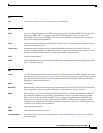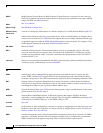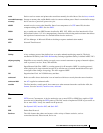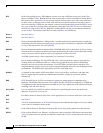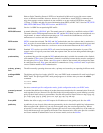
Glossary
GL-9
Cisco ASA 5500 Series Configuration Guide using ASDM
IKE
Internet Key Exchange. IKE establishes a shared security policy and authenticates keys for services
(such as IPsec) that require keys. Before any IPsec traffic can be passed, each ASA must verify the
identity of its peer. Identification can be done by manually entering preshared keys into both hosts or
by a CA service. IKE is a hybrid protocol that uses part Oakley and part of another protocol suite called
SKEME inside the ISAKMP framework. IKE (formerly known as ISAKMP/Oakley) is defined in RFC
2409.
IKE Extended
Authentication
IKE Extended Authenticate (Xauth) is implemented per the IETF draft-ietf-ipsec-isakmp-xauth-04.txt
(extended authentication). This protocol provides the capability of authenticating a user within IKE
using TACACS+ or RADIUS.
IKE Mode
Configuration
IKE Mode Configuration is implemented per the IETF draft-ietf-ipsec-isakmp-mode-cfg-04.txt. IKE
Mode Configuration provides a method for a security gateway to download an IP address (and other
network level configuration) to the VPN client as part of an IKE negotiation.
ILS
Internet Locator Service. ILS is based on LDAP and is ILSv2 compliant. ILS was developed by
Microsoft for use with its NetMeeting, SiteServer, and Active Directory products.
IMAP
Internet Message Access Protocol. Method of accessing e-mail or bulletin board messages kept on a
mail server that can be shared. IMAP permits client e-mail applications to access remote message
stores as if they were local without actually transferring the message.
implicit rule
An access rule automatically created by the ASA based on default rules or as a result of user-defined
rules.
IMSI
International Mobile Subscriber Identity. One of two components of a GTP tunnel ID, the other being
the NSAPI. See also NSAPI.
inside
The first interface, usually port 1, that connects your internal, trusted network protected by the ASA.
See also interface, interface name.
inspection engine
The ASA inspects certain application-level protocols to identify the location of embedded addressing
information in traffic. Inspection allows NAT to translate these embedded addresses and to update any
checksum or other fields that are affected by the translation. Because many protocols open secondary
TCP or UDP ports, each application inspection engine also monitors sessions to determine the port
numbers for secondary channels. The initial session on a well-known port is used to negotiate
dynamically assigned port numbers. The application inspection engine monitors these sessions,
identifies the dynamic port assignments, and permits data exchange on these ports for the duration of
the specific session. Some of the protocols that the ASA can inspect are CTIQBE, FTP, H.323, HTTP,
MGCP, SMTP, and SNMP.
interface
The physical connection between a particular network and a ASA.
interface IP address
The IP address of the ASA network interface. Each interface IP address must be unique. Two or more
interfaces must not be given the same IP address or IP addresses that are on the same IP network.
interface name
Human-readable name assigned to the ASA network interface. The inside interface default name is
“inside” and the outside interface default name is “outside.” See also inside and outside.
interface PAT
The use of PAT where the PAT IP address is also the IP address of the outside interface. See Dynamic
PAT, Static PAT.
Internet
The global network that uses IP. Not a LAN. See also intranet.



